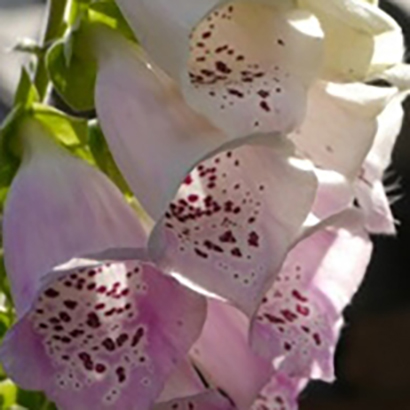I absolutely love foxgloves, they have a magical fairy tale quality and they enhance almost any planting design. I also love the way they pop up all over the place and I am happy to leave them in their chosen spot.
Our native foxglove, Digitalis purpurea, is a welcome visitor in our gardens and there are a vast array of other biennial and perennial foxgloves to choose from. In their first year the biennials produce a rosette of foliage which in the following year will produce a flower spike. To help with the seeding the flower spikes can be cut after flowering and the seed shaken around the garden. Also by cutting down the main flower stem it will encourage the side shoots to produce new spikes of flower.
Some of my favourite foxgloves are listed below, all are easy to find and easy to grow.
Biennial
Digitalis purpurea ‘Alba’ – the white form is lovely planted in shady areas where it produces arrows of light. They look lovely amongst other white flowers and silver foliage.
Digitalis purpurea ‘Pam’s Choice’ – this might be my number 1 foxglove, it has large white flowers with a deep burgundy speckled throat. This colour combination works well in a planting scheme that has deep wine colours in it as the speckled throat picks up the theme. Try it with Astrantia ‘Hadspen Blood’, Sanguisorba officinalis ‘Tanna’ or amongst a lovely dark rose such as Rosa ‘Munstead Wood’.
Digitalis purpurea ‘Sutton’s Apricot’ – this is a really subtle colour and not as yellow as the name implies. It is a delicate baby pink with a slight apricot hue which works well with soft lemon yellow such as Geum ‘Banana Daiquiri’.
Digitalis purpurea ‘Foxy’ – the foxy hybrids come in colours of purple, rose, lavender, cream, yellow and white. Unlike other biennials these will flower in the first year and carry the large flowers all around the stem.
Perennial
Digitalis x mertonensis – this has the largest flowers of any foxglove and they are a striking crushed strawberry colour. I use this a lot as the colour seems to work well in all situations.
Digitalis ‘Camelot’ Series – these carry the flowers around the stem and come in a palette of complementary colours , lavender, cream, rose and white and are available to buy as a single colour if you have a particular scheme to work to.
You really can’t go wrong when planting foxgloves, whether your garden is formal, natural, modern, traditional, urban or country. The key is to plant as many as possible to give a magnificent display and with the self-seeding your stocks will increase as time goes by.
A few interesting foxglove facts.
- Foxgloves as cut flowers will keep all the other flowers in the vase fresher for longer.
- The name Digitalis is derived from the Latin digitus meaning finger, referring to the shape of the flower.
- Foxgloves are highly poisonous.
- Digitalis is a source of digitoxin which is used in medicine as a heart stimulant.
Keep an eye out for Digitalis purpurea growing wild and take inspiration from nature and try some in your own garden.

